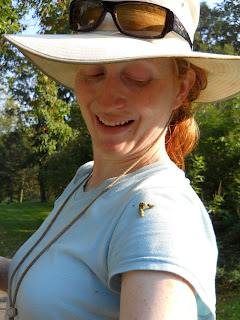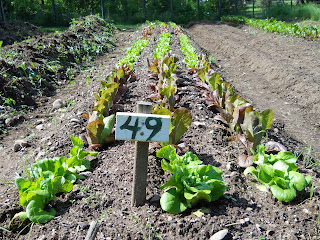To forget how to dig the earth and tend the soil is to forget ourselves.
-Gandhi
The concept of nutrition has taken on new meaning since I've been working in the garden. Whereas at Food & Friends I was concerned about the clients getting enough calories, protein, vitamins, and minerals to nourish their bodies while living with HIV or cancer, now I think about the microbes in the soil and whether or not they are getting the nourishment they need to support the growth and nutrient uptake of the plants. There can be up to 6 billion microbial life-forms in a quarter-sized chunk of compost. By attaching themselves to the root hairs of plants and creating large networks of tiny absorptive fibers, the fungi in the soil allow plants to take up more nutrients while using the sugars from the plants to feed themselves, a true symbiotic relationship.
Compost in garden = nourished microbes = healthy soil = healthy plants = more nutritious vegetables
This is why composting is so fascinating to me, besides appealing to my practical nature. Every week I watch pounds and pounds of food scraps from the dorm, the cafe, the school, and the food co-op kitchen being layered with leaves and cut grass from the lawns then being transformed into a rich food for microbes and worms. In biodynamic agriculture, this process is aided by special preparations made from dandelions, chamomile, oak bark, nettles, yarrow, and valerian which are added to the compost piles in small amounts. Combining this "kitchen" compost with compost made from horse manure and some sand to improve drainage yields the potting soil that is used in the greenhouse where the plants start their lives. The kitchen compost will also be used to fortify the soil in the beds where those greenhouse plants will be transplanted when they are large enough to withstand the elements. Later, the vegetables from those plants will be harvested and eaten by the interns and the customers in the cafe and the scraps will go to the compost piles and the cycle keeps going. I love this closed loop!
October gave me additional opportunities to ponder closed loop systems with a workshop on permaculture and biodynamics. Permaculture is a contraction of the words "permanent" and "agriculture". It was coined by Bill Mollison, an Australian who developed this form of sustainable agricultural design, along with David Holmgren, in the 1970's. Permaculture's guiding principles are based on ways of working with the natural world that indigenous peoples have practiced for thousands of years. It challenges "scarcity thinking" by looking at the world through a lens of sustainable abundance, which translates to planting perennial vegetables instead of the typical annual varieties, creating edible forest gardens, building soil on barren land through composting, and developing closed loop systems for homesteads and larger scale land use with thoughtful landscaping practices. Are you getting all this? Click here for a clearer explanation:
http://en.wikipedia.org/wiki/Permaculture#Sustainable_designs

You can imagine that my mind was racing after this workshop. Fortunately, 6 inches of snow arrived to clear my head later that afternoon. This unseasonable weather allowed me to get out my cross-country skis ahead of schedule which I didn't mind one bit. However, the 5-day power outage caused by the heavy, wet snow falling on the still leafy trees leading to branches falling onto the power lines was not quite as much fun as the skiing, especially when the hot water ran out in the dorm. The candlelit evenings in the kitchens with my dormmates were rather nice though. An unexpected bonus from the storm was learning how to use a chain saw. Program Director Mac Mead took us through the inner workings of these intimidating machines before giving each intern some one-on-one time with the large oak branch that was blocking part of a driveway in the garden. I'm not too keen on the vibration and the fumes from the saw, and OK, the possibility of cutting off a limb is a bit daunting, but I'm glad to have a basic working knowledge of the machine.
Also new on my growing list of skills, how to play a wizard with a long, fluffy beard, pointed hat, and oversized robe surrounded by smoking wood fires and torches while handling dry ice and standing in mud on a cold Halloween night. This made my parading through the hot and humid streets of DC dressed as a bunch of grapes for the Pride parade seem like a relaxing walk in the park despite the fact that no one was trying to rip my costume off on Halloween. I really need to get a job handing out fliers on a city street while dressed as a banana or a gorilla or something to get this penchant for costumes, which I'm certain is linked to my Hungarian heritage, out of my system.
BEE UPDATE- Several hundred pounds of sugar have been used to produce bee tea over the past several weeks. The bees are lapping it up and turning it into honey to be stored for winter use, though not as quickly as expected. Honey from one of the stronger hives was transferred to a weaker one to give it a boost. Unused portions of the hives are being removed to reduce the risk of the bees freezing over the winter. I received my 3rd sting of the season, a nice "kiss" on the cheek which has left my face looking a bit swollen and distorted. Intern MaryAnn comforted me by noting all the money we're saving on Botox with these stings...
My roasted rutabaga dish is calling me, so I'll say so long for now. Thanks for reading.


















































